





Cover crops are grasses, legumes or small grains grown between regular crop production periods for the purpose of protecting and improving the soil
Cover crops have been used for centuries; however, today's gardener has grown up in a generation which has replaced the use of cover crops with widespread use of fertilizers and herbicides. Now as some gardeners are trying to use cover crops, they often lack the information and experience to be successful. University and private researchers are going back to the basics and experimenting with beneficial plants to determine how they can best be used in gardening practices to supplement or replace chemical fertilizers. Cover crops have an important role in successful sustainable gardening.
The main purpose of a cover crop is to benefit the soil and/or other crops, but is not intended to be harvested.. Some of the primary benefits from cover crops include:
Which cover crop is right for you? You have to keep in mind the time of year and the species you are growing. Some, such as rye, are very cold-tolerant and work well for late-season plantings. Others, such as buckwheat, are very frost-tender. The cover crops listed here are widely adapted and can be grown in most areas of the United States, either as a summer or winter cover crop, depending on where you live.
Clover. Clover comes in a plethora of different shapes and sizes. White Dutch clover works well as a living mulch, since it tolerates both shade and traffic. Yellow blossom sweet clover is an excellent nutrient scavenger and helps build good soil structure. Crimson clover attracts beneficials and looks great, too. Whatever the color, clover fixes nitrogen and helps to build rich soils. By the way, the state of Vermont adopted Red Clover as its state flower in 1895, recognizing it as both an integral part of many cultivated hay fields and a common sight along numerous Vermont roadsides.
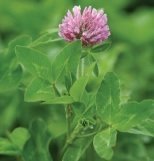
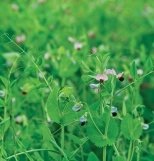 Red Clover Winter Rye
Red Clover Winter Rye
Rye. This crop comes in two different types: annual rye and cereal rye. Both have their advantages. Sow cereal rye during the late summer or early fall, and it will grow until late in fall and resume growing in spring. With annual rye, which winterkills in USDA Plant Hardiness Zones 5 and colder, you'll be able to plant your garden earlier, since you won't have to turn the cover crop into the soil and then wait three weeks as you would with a perennial cover crop.
Field peas/oats. This dynamic duo combines the benefits of a legume (peas) that fixes nitrogen and a grain (oats) that contributes plenty of organic matter. And the plants have complementary growth habit-the peas climb right up the oats. Both crops are cold-tolerant, which makes this a good mixture to plant in late summer or early fall. In colder climates, they will also winterkill, allowing an early spring start.
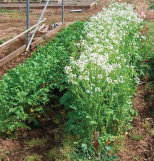 Field Peas Oilseed Radish
Field Peas Oilseed Radish
Oilseed Radish. The extra long tap root breaks up and aerates the soil in addition to drawing up nutrients. When turned under just before flowering, its decomposition helps to control soil born pests.
Sorghum-sudangrass. As its name suggests, this grass is a cross between sorghum and sudangrass. This hybrid generates large amounts of organic matter and needs little encouragement to grow 5 to 12 feet tall. You can keep this frost-tender plant in check by mowing it down to 6 inches when it reaches a height of 3 feet or by planting it just seven weeks before frost. 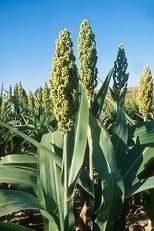
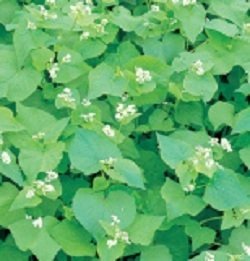 Sorghum Buckwheat
Sorghum Buckwheat
Buckwheat. It's not wheat, and it's not a Little Rascals character! Buckwheat is a broadleaf plant and an excellent smother crop-it's effective even against weeds like quackgrass. "Buckwheat is very fast-growing and can provide a quick canopy to shade weeds. Just be careful to not let it go to seed, or you'll have buckwheat in your next crop," says Dr. Creamer. It matures in just six to eight weeks and can be squeezed in between spring and fall vegetable plantings. Buckwheat's white flowers serve two purposes-they work well as a filler for flower arrangements, and they attract beneficial insects.
I prefer to use "mixes" for my cover crops, here are a couple of examples.
Fall Green Manure Mix. This ready-made mix is comprised of winter rye, field peas, ryegrass, crimson clover and hairy vetch. Vigorous late summer growth provides winter erosion control. The peas, clover and ryegrass will winter kill to provide organic matter and soil cover. The hairy vetch and winter rye will regrow in the spring to provide nutrients for crops to utilize. Because the seeds of this mix vary in weight and size, it is best seeded with a grain drill.
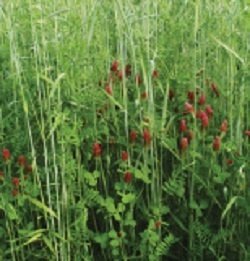 Green Manure Mix
Green Manure Mix
Spring Green Manure Mix. The mix contains 60% field peas, 25% oats, and 15% hairy vetch. Designed for spring sowing, but it may be sown anytime early spring through late summer. Sow 5 lb./1,000 sq.ft. (200 lb./acre) and cover lightly. For green manure, incorporate into the soil anytime your garden schedule suggests. Mid and late summer sowings may be left to winter over and the vetch allowed to regrow some in the spring. grown.
In some areas, cover crop seed can be hard to find in the fall. Check with local feed stores, co-ops or mail order sources. I personally recommend Johnny's Selected Seeds for mail orders. They have an excellent selection and their catalog or web site provides information on each variety of seed.
Photos courtesy of Johnny's Selected Seed.
Copyright © www.100flowers.win Botanic Garden All Rights Reserved